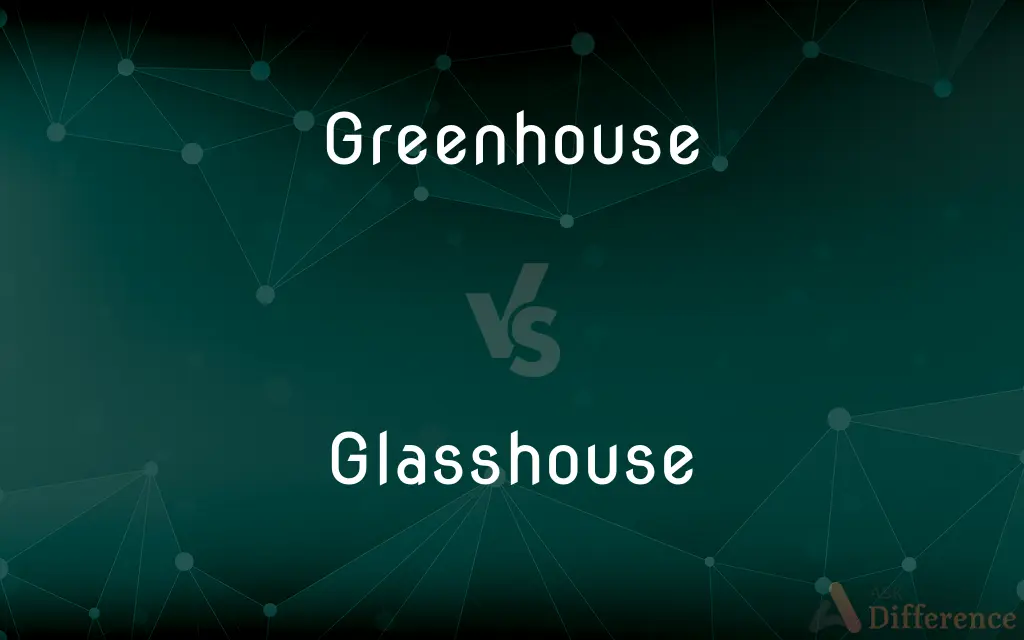Greenhouse vs. Glasshouse — What's the Difference?
By Urooj Arif & Fiza Rafique — Updated on February 29, 2024
A greenhouse is a structure designed to cultivate plants by trapping heat, while a glasshouse is a type of greenhouse made primarily of glass to maximize light entry. The term "glasshouse" emphasizes the material, whereas "greenhouse" focuses on function.

Difference Between Greenhouse and Glasshouse
Table of Contents
ADVERTISEMENT
Key Differences
Greenhouses and glasshouses are both structures used to create controlled environmental conditions for the growth of plants. The primary purpose of a greenhouse is to trap solar radiation to create a warm, stable environment that promotes plant growth, extending the growing season beyond what is naturally possible in a given location. Greenhouses can be made from a variety of materials, including glass, plastic sheets, and polycarbonate panels, each selected for its ability to transmit light and retain heat.
The term "glasshouse" specifically refers to greenhouses constructed mainly or entirely of glass. The choice of glass as a material is due to its high transparency, allowing maximum sunlight to enter while providing strong protection against the elements. Glasshouses are often associated with the cultivation of delicate plants, such as exotic flowers and vegetables, which require precise temperature and humidity conditions. They are also commonly used in botanical gardens and research facilities for the purpose of displaying and studying plant species.
All glasshouses are greenhouses, but not all greenhouses are glasshouses. The distinction lies in the construction material: a glasshouse is a subtype of greenhouse distinguished by its glass construction. In regions or contexts where the distinction is emphasized, "glasshouse" conveys an image of a more traditional or elaborate structure, often with aesthetic as well as functional design considerations.
The choice between using "greenhouse" or "glasshouse" often depends on regional preferences and the specific context of the conversation. In some areas, "glasshouse" might be more commonly used to describe large, commercial, or public botanical display houses, whereas "greenhouse" is a broader term that applies to any structure used to create a controlled environment for growing plants.
Despite the material differences, the ultimate goal of both greenhouses and glasshouses is the same: to provide a controlled environment that enhances plant growth. Decisions about design, materials, and construction are driven by factors such as the types of plants being grown, the local climate, and the specific needs of the gardener or researcher.
ADVERTISEMENT
Comparison Chart
Primary Purpose
To create a controlled environment for plant growth
Same as greenhouse, with emphasis on maximum light entry
Materials
Glass, plastic sheets, polycarbonate panels
Primarily or entirely made of glass
Light Transmission
Varies by material, generally high
Maximum, due to glass construction
Usage
Broad, including commercial and personal cultivation
Often associated with delicate plants, botanical gardens, and research
Focus
Functional, to extend growing seasons and protect plants
Material-specific, often with aesthetic considerations
Types of Plants Grown
Wide variety, including vegetables, flowers, and exotic plants
Delicate plants requiring precise conditions
Compare with Definitions
Greenhouse
A greenhouse is a structure that creates a favorable environment for plant growth year-round.
Farmers use greenhouses to grow tomatoes during winter.
Glasshouse
A glasshouse is a greenhouse made primarily of glass for plant cultivation.
The botanical garden's glasshouse contains rare tropical plants.
Greenhouse
Greenhouses are versatile in size and usage.
She built a small greenhouse in her backyard for herbs and flowers.
Glasshouse
It emphasizes aesthetic design as well as functionality.
The Victorian glasshouse is a centerpiece of the historical garden.
Greenhouse
They are essential for research and commercial farming.
Research greenhouses study plant responses to controlled environments.
Glasshouse
Glasshouses are often used for display and education.
The university's glasshouse serves as a living classroom for botany students.
Greenhouse
It can be made from various transparent materials.
The new greenhouse uses polycarbonate panels for better insulation.
Glasshouse
They provide maximum light transmission for plants.
Exotic orchids thrive in the glasshouse's bright environment.
Greenhouse
Greenhouses help in starting seedlings early.
Starting seeds in a greenhouse allows for an early jump on the spring planting season.
Glasshouse
Glasshouses can be architectural landmarks.
The large glasshouse in the city park is known for its intricate ironwork and glass panels.
Greenhouse
A greenhouse (also called a glasshouse, or, if with sufficient heating, a hothouse) is a structure with walls and roof made chiefly of transparent material, such as glass, in which plants requiring regulated climatic conditions are grown. These structures range in size from small sheds to industrial-sized buildings.
Glasshouse
A greenhouse.
Greenhouse
A glass building in which plants that need protection from cold weather are grown.
Glasshouse
A place, position, or situation involving intense public scrutiny.
Greenhouse
A structure, primarily of glass or sheets of clear plastic, in which temperature and humidity can be controlled for the cultivation or protection of plants.
Glasshouse
A greenhouse, especially one for commercial use.
Greenhouse
To nurture in order to promote growth.
Glasshouse
A building where glass or glassware is manufactured.
Greenhouse
A house in which tender plants are cultivated and sheltered from the weather.
Glasshouse
A house where glass is made; a commercial house that deals in glassware.
Greenhouse
A building with glass walls and roof; for the cultivation and exhibition of plants under controlled conditions
Glasshouse
A building with glass walls and roof; for the cultivation and exhibition of plants under controlled conditions
Common Curiosities
Why choose a glasshouse over other types of greenhouses?
A glasshouse is chosen for its aesthetic appeal and superior light transmission, ideal for delicate plants and public display.
How do greenhouses control the internal environment?
Greenhouses control temperature, humidity, and sometimes CO2 levels using ventilation, heating, cooling systems, and shading.
Is a glasshouse suitable for cold climates?
Glasshouses can be used in cold climates with appropriate heating and insulation, though they may require more energy to maintain optimal temperatures.
Are glasshouses more expensive than other greenhouses?
Yes, due to the material and construction, glasshouses can be more expensive than greenhouses made with alternative materials.
Can any plant be grown in a glasshouse?
While many plants benefit from the conditions in a glasshouse, care must be taken with plants sensitive to intense sunlight or heat.
How do greenhouses contribute to agriculture?
They allow for year-round cultivation, early seed starting, and protection from adverse weather, pests, and diseases, enhancing food production.
Why are glasshouses important for botanical gardens?
They enable the cultivation and display of a wide range of plants from different climates, serving educational and conservation purposes.
What maintenance is required for a glasshouse?
Regular cleaning of glass, monitoring of climate control systems, and pest and disease management are essential for maintaining a healthy environment.
What is the environmental impact of greenhouses and glasshouses?
They can have a positive impact by enabling local food production and research; however, energy use for heating and cooling is a consideration for sustainability.
Can I build a greenhouse or glasshouse in my backyard?
Yes, many options range from simple kits to elaborate custom designs, suitable for backyard gardening enthusiasts.
Share Your Discovery

Previous Comparison
Grommet vs. Eyelet
Next Comparison
Priest vs. ReverendAuthor Spotlight
Written by
Urooj ArifUrooj is a skilled content writer at Ask Difference, known for her exceptional ability to simplify complex topics into engaging and informative content. With a passion for research and a flair for clear, concise writing, she consistently delivers articles that resonate with our diverse audience.
Co-written by
Fiza RafiqueFiza Rafique is a skilled content writer at AskDifference.com, where she meticulously refines and enhances written pieces. Drawing from her vast editorial expertise, Fiza ensures clarity, accuracy, and precision in every article. Passionate about language, she continually seeks to elevate the quality of content for readers worldwide.













































